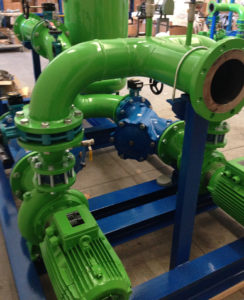Cooling tasks in compressed air
Industrial facilities largely employ compressed air, used both for pneumatic drives and control equipments. Compressed air is supplied by compressors that can widely vary on sizes and capacities, from small workshop compressors up to very powerful and complex compressor rooms. Anyway, these machinery produces heat, thus needing a dedicated cooling system. On small machines, this is installed directly on board (or the compressor can even cool itself leveraging the surrounding ambient air), while on bigger plants there is the need of a dedicated solution able to supply cooled water to circulate among the compressors.
Air compressors usually don’t require a very high level of cold. Required temperatures of the cooling water are indeed around +30 / +40° C. Therefore this is a kind of application that can be deployed with a cooling solution that employs:
- Evaporative towers
- Closed-circuit evaporative coolers
- Dissipators (dry cooler)
The selection of one type of solutions instead of another depends upon some factors, such as the availability on board of compressor of interface exchangers and the climatic conditions of the installation site. Depending on the fact exchangers are available or not on board of the compressor, indeed, the cooling can be achieved using a cooling tower or a closed circuit cooler. This solution is suitable because letting tower water circulate directly within the jackets of the compressor entails a high fouling and clogging risk, causing irreparable damages to the compressor, or anyway leading to very high maintenance costs.
In addition, it is to be noticed that, even if they don’t need cooling water at very low temperatures, compressors can anyway reach high wall temperatures nearby their ‘hot spots’, causing the precipitation of carbonates within the circulating water. Using non treated and scaling water, this phenomenon leads to a quick obstruction of the flowing chambers of the water itself. When ambient temperatures allows it, it’s thus of course best suitable to install dry-coolers or dissipators, in order to have availability of closed-circuit water avoiding water contamination.
Another application related to air compressors is referred to the compressed air itself, which has to be dehumidified and dried in order to be suitable for employ within the served processes. Humidity in compressed air can cause indeed devastating effects to all of the equipments that employs it, such as pneumatic drives, blowing guns, pneumatic tools, regulating valves and control and measurement equipments. In order to eliminate the humidity from the compressed air it is possible to employ dryers using thermal cycles. These machines cool the compressed air making it flow along surfaces at low or extremely low temperature, forcing the condensation of water contained in the air, which is then separated. The result is compressed air with a lower absolute water content as output, while using a following post-heating cycle it’s possible to control its relative humidity. Wisely working with temperatures, it’s then possible to achieve quite high dryness levels.
These systems are based on refrigerating groups combined with surface heat exchangers: the air circulates within the secondary circuit of the exchanger, while inside the primary there can be several different fluids flowing, depending on the temperature levels required and the kind of pants. The options are:
- Freon (direct expansion)
- Water with antifreeze additivation
- Cold water
In most recent years these systems had a very strong growth thanks to the increasing efficiency offered by heat exchangers, more innovative, compact and performing compared to traditional shell and tube exchangers. These are systems that are more and more employed in function of dryers for this kind of application. There are indeed by now hundreds of applications made using plate heat exchangers, even on significant compressed air flow rates and even on technical gases production plants. Plate heat exchangers are indeed employed as dryers:
- On the output of distillation columns for the final cooling in the production of various types of gas
- On the input, cooling the incoming air in compressors
These are in fact more and more popular applications, that require anyway expertise in the sizing and in terms of installation attentions, especially when evaluating the condensations engendered during the air dehumidification process.




 Back to index
Back to index Download the complete book
Download the complete book